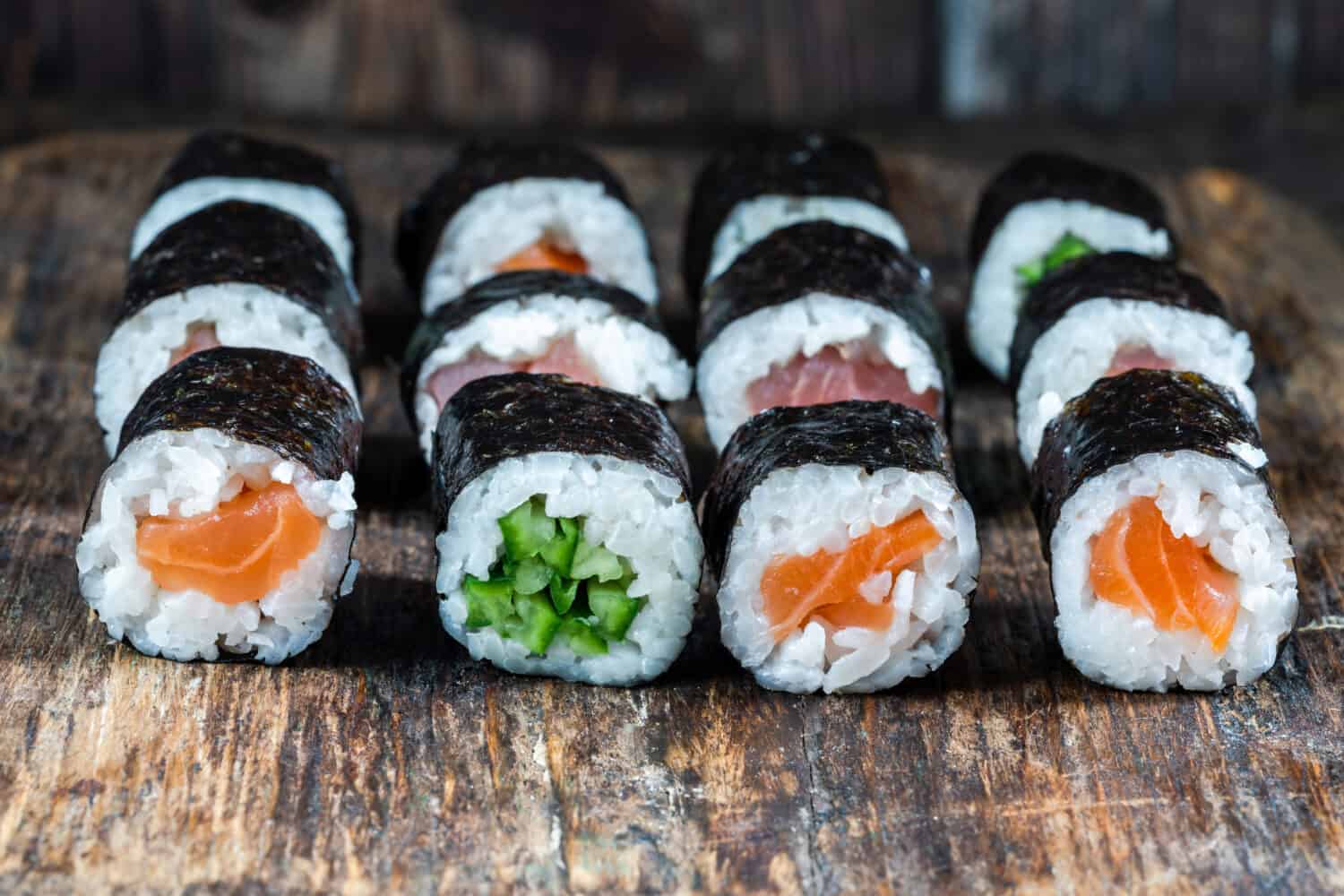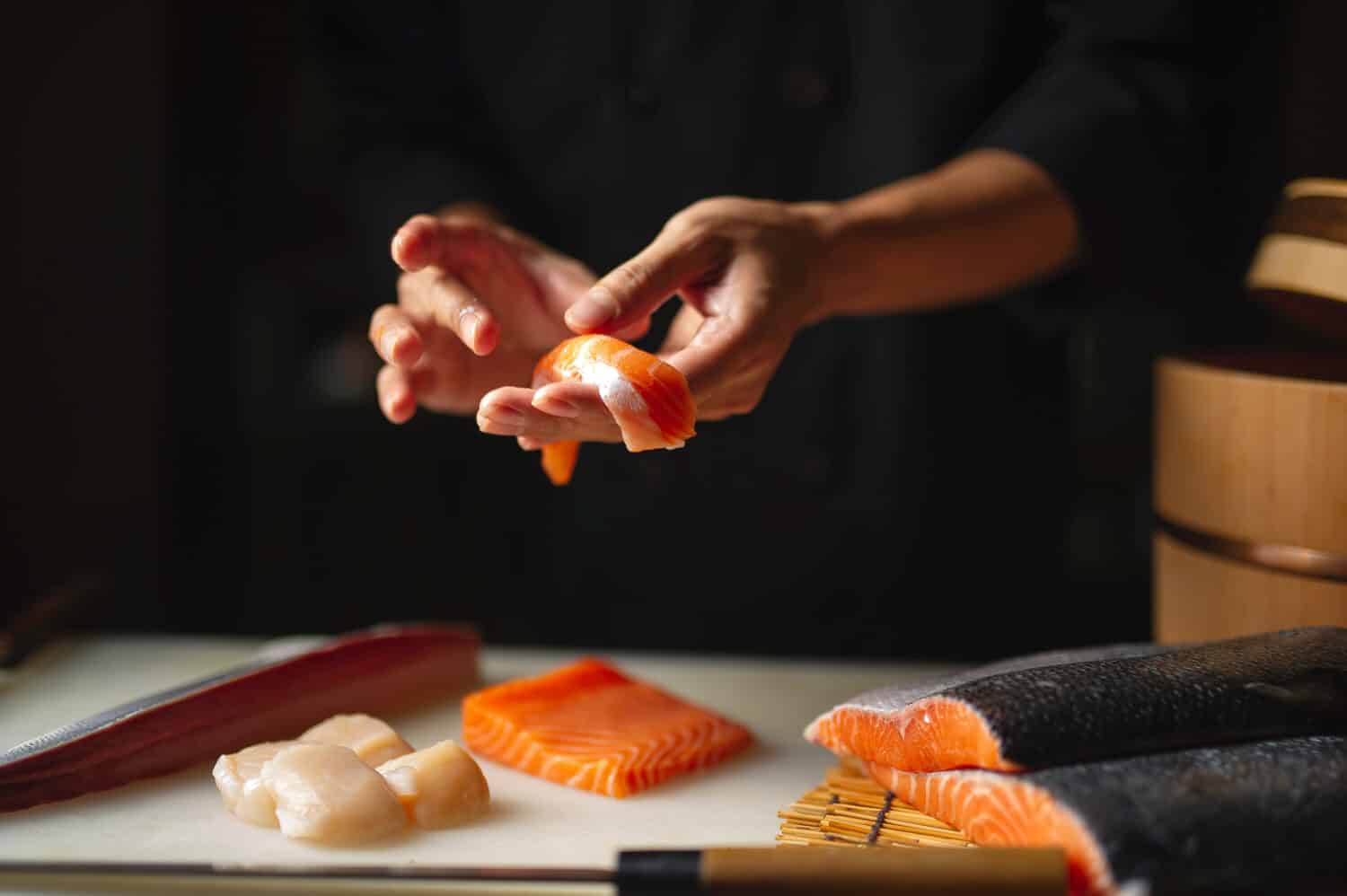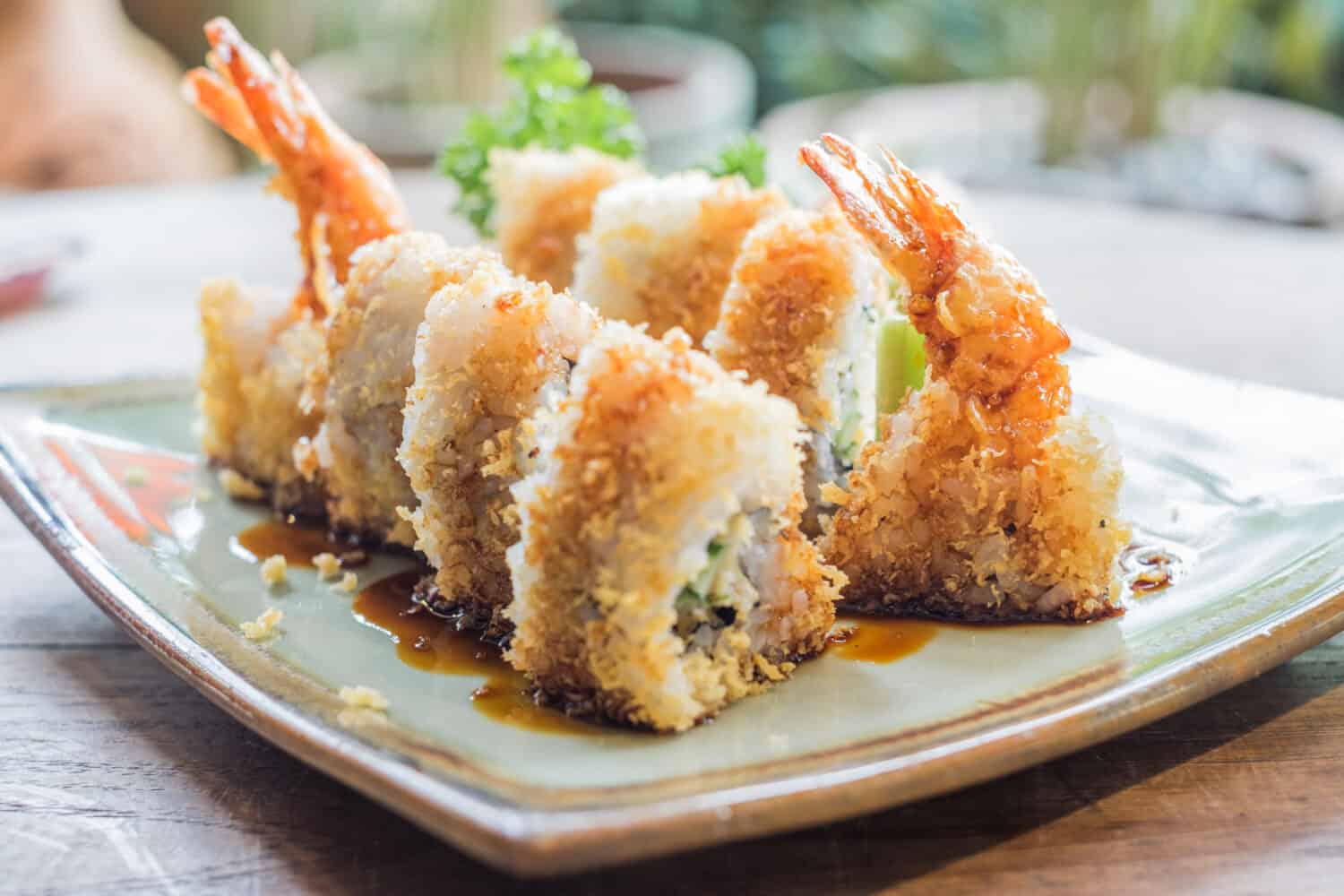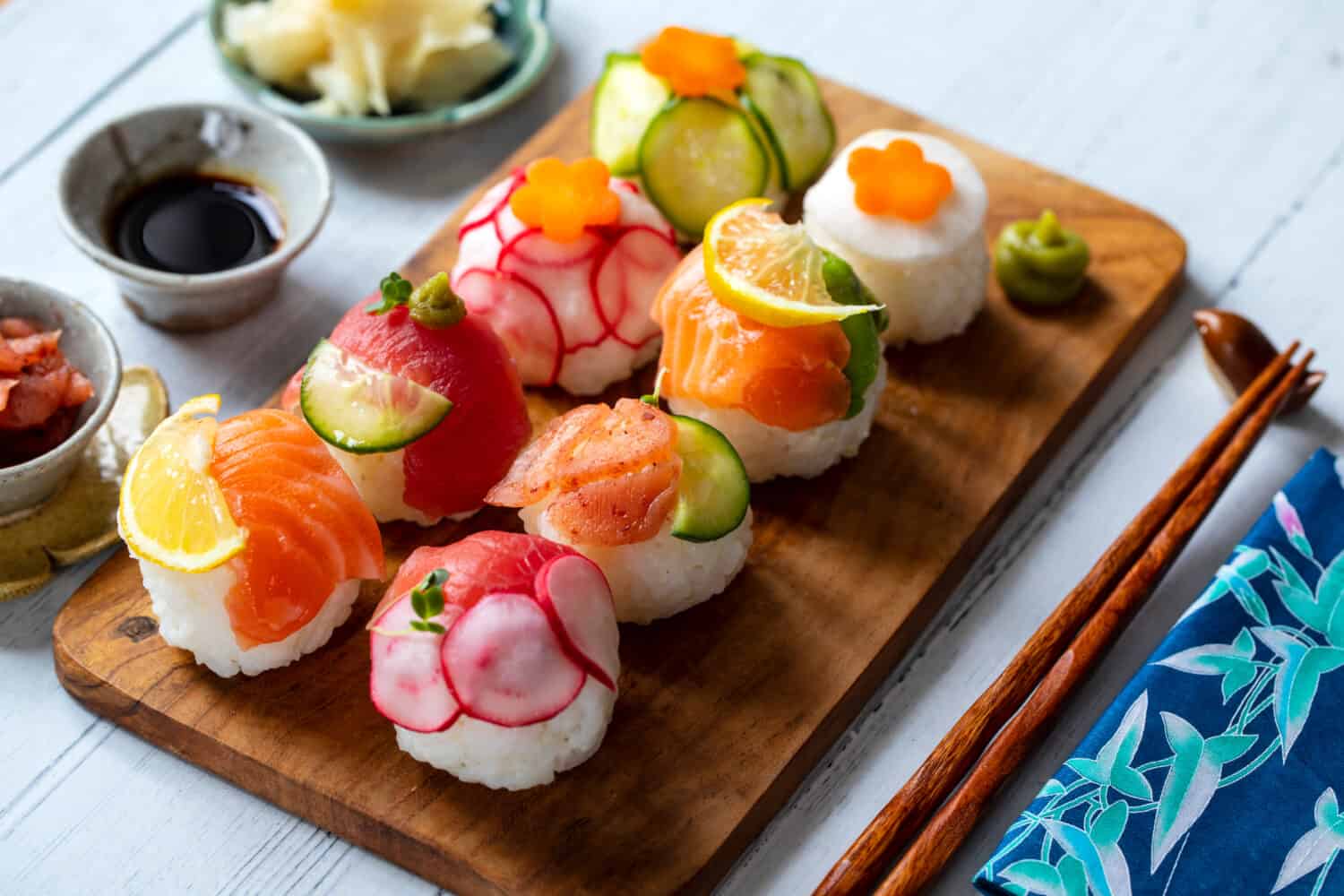Many people believe that sushi is a healthy food option. Sushi includes fresh ingredients like fish and seaweed, but how healthy is it? While sushi uses lean protein, has little saturated fat, and typically comes with vegetables, it does have its downsides. Also, there are many kinds of sushi; some types are healthier than others. We will examine the health benefits of sushi and determine if this popular Japanese cuisine is a healthy food choice.
Sushi: What is it?
Sushi is made with rice, seafood, and vegetables. The most essential ingredient in sushi is rice. In fact, “sushi” refers to the sour taste of the vinegar-flavored rice used to make it. Pickled ginger, soy sauce, and wasabi are popular sides with sushi. There are many kinds of sushi, but here are the five most common types.
The five most common types of sushi
- Nigiri: Translated as “hand-pressed sushi,” Nigiri is a type of sushi consisting of a small mound of oval-shaped rice topped with a slice of raw or cooked seafood. The seafood is usually tuna, salmon, or shrimp. Garnished with a small amount of wasabi and sometimes bound with a strip of seaweed known as nori, Nigiri is eaten in a single bite.
- Sashimi: While this is technically not sushi, it often appears on sushi menus. Sashimi is thinly sliced raw fish served without rice. Soy sauce, wasabi, and pickled ginger are popular condiments for Sashimi sushi.
- Maki: This sushi consists of a layer of rice, seaweed (nori), and either veggies or fish. This cylindrical-shaped sushi is made using a bamboo mat. There are three types of maki sushi.
- Uramaki – The rice is on the outside of the roll, and the nori wraps around the filling, e.g., California rolls.
- Futomaki – Large, thick rolls filled with various ingredients, such as vegetables, seafood, and cooked eggs.
- Hosomaki – This thinly rolled sushi only contains one primary ingredient, often fish, wrapped with rice and nori.
- Temaki: This hand-rolled sushi contains a sheet of nori filled with rice, seafood, vegetables, and sometimes other fillings. Rolled into a cone shape, it is typically eaten with the hands.
- Inari: This sushi is in a fried and seasoned tofu pocket stuffed with sushi rice. Slightly sticky with a mild vinegar taste, it is popular in Bento boxes.

©BBA Photography/Shutterstock.com
The combinations of food within these five varieties of sushi are endless. In addition to traditional sushi varieties, many restaurants offer their own spins on sushi rolls. Just as the combinations vary, so do the health benefits.
Sushi: Health benefits
Sushi is a good source of lean protein, primarily from fish or seafood. Fish like salmon and tuna are rich in protein and provide essential omega-3 fatty acids, which are known to support heart and brain health.
Sushi also incorporates vegetables and seaweed. Vegetables like avocado, cucumber, and carrots provide vitamins, minerals, and dietary fiber. Nori, the seaweed typically used to wrap sushi rolls, is rich in minerals and is also a good source of antioxidants.
Sushi portions vary, but sushi typically comes in small rolls. Despite the small servings, sushi is very filling, which appeals to people watching their weight.
Sushi: The less healthy aspects
Despite its many health benefits, some types of sushi are less healthy than others. Specialty rolls, like those with mayonnaise, cream cheese, or food fried in tempura, can significantly increase a sushi meal's calorie and fat content. Also, if given an option between white or brown rice, choose brown rice. Brown rice is the healthier choice because it contains more fiber, protein, and vitamins than white rice.
While sushi has nutrient-rich fish and vegetables, it also contains high sodium levels, often caused by using too much soy sauce. High sodium intake can cause hypertension and an increased risk of heart disease. Furthermore, the pickled ginger served with sushi may contain a lot of sugar, adding empty calories to your meal.
Mercury in sushi is also a concern. Tuna and swordfish tend to have higher mercury levels due to their position in the food chain. Overeating fish with high mercury levels may have adverse health effects. Pregnant women and young children are most at risk for mercury poisoning.
Finally, raw fish may cause foodborne illness if not handled and stored correctly. Even if one is vigilant about food safety, there is always a small risk of food contamination. Again, pregnant women and people with weaker immune systems should eat sushi in moderation due the contamination risk.

©Chalee foodies studio/Shutterstock.com
Sushi: How many calories is there is one piece of sushi?
The number of calories in one piece of sushi varies depending on the type of sushi and its ingredients. However, the average calories for one piece of sushi ranges from ten to seventy calories for fresh, raw sushi. Sushi consisting of tempura or fried foods have much higher calories. The variety of sushi also influences the calorie count.
Nigiri sushi, usually made with tuna or shrimp, typically has up to seventy calories per piece. Sashimi, made of sliced raw seafood, has ten to thirty calories. Maki sushi has the largest caloric differences because of the many varieties and food combinations. However, Maki vegetable rolls range from thirty to forty calories per piece, whereas Maki made with meat or tempura may have up to one hundred calories per piece.
Sushi: What are the healthiest menu options?
When eating out, here are the best kinds of sushi to consider.
- Rainbow Roll: This colorful sushi usually contains avocado, crab, and cucumber, It may also have salmon or tuna. This sushi is high in protein and is a good source of vitamins and minerals.
- Salmon Avocado Roll: This super-combination is an excellent source of vitamins, healthy fats, and protein.
- Mackerel Roll: If you are tired of salmon and tuna, switch it up with mackerel. Like salmon, mackerel has omega-3 fatty acids, which are good for the heart and support brain health.
- Vegetable Rolls: Sushi rolls like cucumber and avocado are tasty without added fats or sugars.
Avoid sushi rolls that come with high-calorie sauces like dragon rolls. Rolls like the Philadelphia Roll that use cream cheese should also be avoided because it is high in saturated fats and cholesterol. Finally, sushi made with shark and swordfish may contain high amounts of mercury, so eat only small amounts of these delicacies.

©Pornthep Vongmatavee/Shutterstock.com
In Summary
Sushi can be a healthy food choice, but there are several caveats. The good news is that sushi contains vegetables, seaweed, and lean proteins, all of which contain vitamins and minerals. It is also low in saturated fats and tends to be low in calories, not to mention the smaller but filling portion sizes. It is an excellent choice for those managing their weight.
However, the healthiness of sushi varies depending on the ingredients, preparation methods, and portion sizes. Some specialty rolls can be high in added fats and calories, so these kinds of rolls should be eaten in moderation. Some sushi, like Dragon Rolls, may come with high-calorie sauces. Always be mindful of how much soy sauce and condiments you eat with your sushi.
Furthermore, there is a risk of mercury poisoning when eating raw fish. Pregnant mothers, children, and those with weaker immune systems should be cautious about how much sushi they consume. There is also a slightly higher risk of food poisoning with sushi. However, if you opt for healthier sushi options more frequently than the less healthy ones, you can certainly enjoy sushi as a part of a well-rounded diet.
The image featured at the top of this post is ©Magdanatka/Shutterstock.com.
